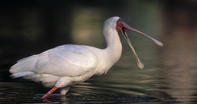
Name
African Spoonbill (Platalea alba)Appearance
The African spoonbill is a long-legged wading bird with a height of 90 cm. Its body is predominantly white and the face, bill and legs red. It has a wingspan of 36 - 40c m.
This bird can be easily identified by its uniquely spoon-shaped bill. Both the male and female birds are similar in appearance. At birth, the African spoonbill is born with a short bill that gradually develops into its spoon-like shape. It usually resembles a spoon right before it is time to leave its nest.
African Spoonbill Diet
The African spoonbill's diet consists mainly of fish and aquatic invertebrates such as crustaceans, shellfish, insects, larvae and molluscs.African Spoonbill Breeding
The African spoonbill usually breeds in colonies from late March to September in South Africa. The nest is a platform of sticks or reeds in a tree near water but can also be found in swamp reeds, among rocks, marsh plants or cliffs.
The inside of the nest is often lined with leaves. The female may lay 3-5 eggs during the month of April or May. These eggs are usually spotted with coloured dots of red, brown or blue.
The eggs are incubated by both parents for up to 29 days. They also both look after the chicks for 20-30 days. The young spoonbills begin to fly after another four weeks.
African Spoonbill Behaviour
The African spoonbill is a shy and alert bird and is usually found singly but can also be seen in pairs or groups. It rarely makes a sound except for an occasional grunt when alarmed.
The spoonbill flies with its neck and legs extended while flapping its wings steadily in the air. The African spoonbill fishes for food by swinging its partly opened bill from side to side in shallow water. The bill acts as a scythe (hooked tool) to catch fish, crustaceans etc.
 SouthAfrica.co.za provides informative, educational content on many South African bird species that orthologists and bird-watchers would enj...
SouthAfrica.co.za provides informative, educational content on many South African bird species that orthologists and bird-watchers would enj... South Africa is a dry country; its rivers are often stretches of sand rather than of flowing water....
South Africa is a dry country; its rivers are often stretches of sand rather than of flowing water....